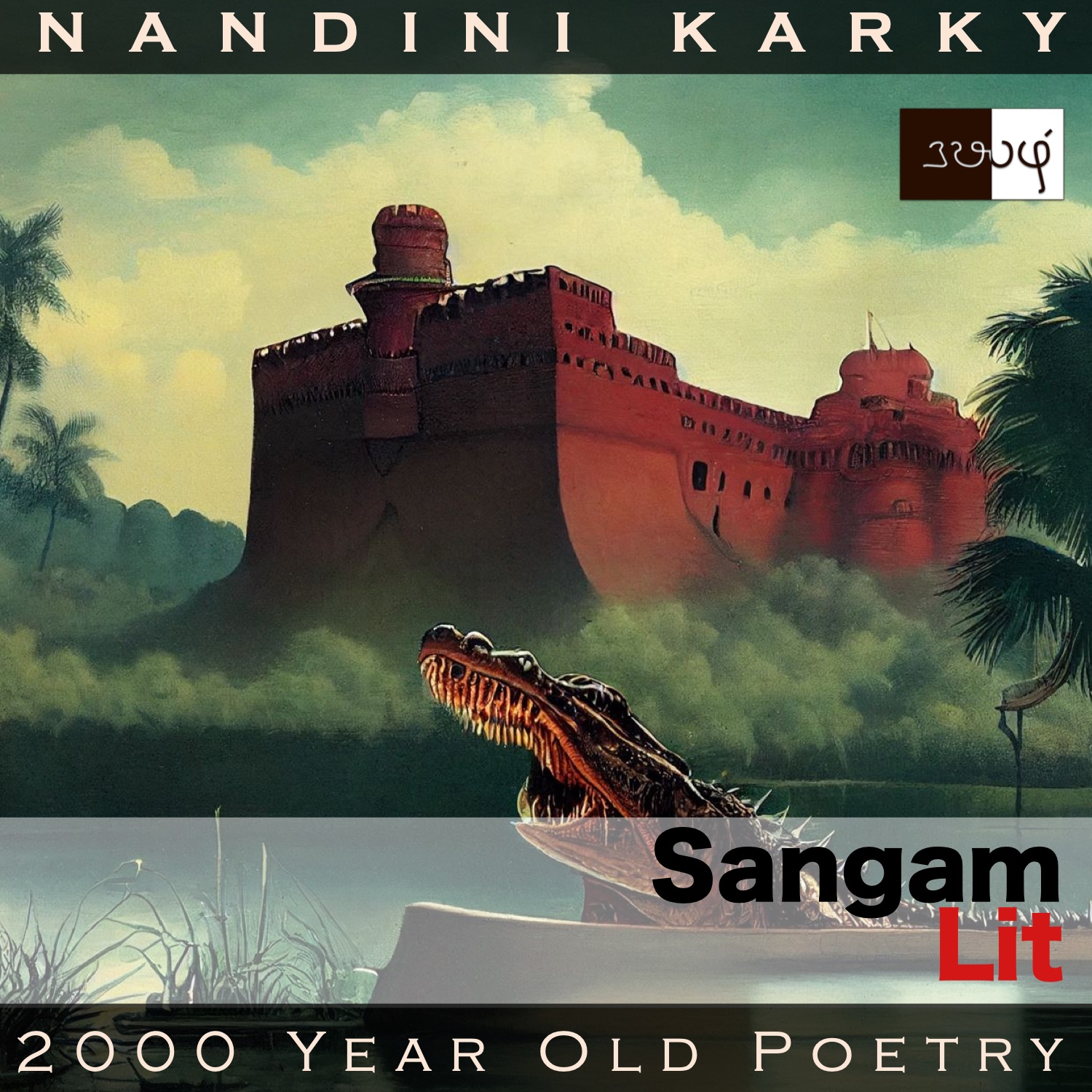Podcast: Play in new window | Download
Subscribe: Apple Podcasts | Spotify | Amazon Music | Android | iHeartRadio | Email | TuneIn | RSS | More

In this episode, we perceive the intrepid nature of a king, as portrayed in Sangam Literary work, Puranaanooru 37, penned about the Chozha King Kulamutrathu Thunjiya Killivalavan by the poet Maarokkathu Nappasalaiyaar. Set in the category of ‘Vaagai Thinai’ or ‘king’s victory’, the verse renders indirect praise by depicting the strength of an enemy king.
நஞ்சுடை வால் எயிற்று, ஐந் தலை சுமந்த,
வேக வெந் திறல் நாகம் புக்கென,
விசும்பு தீப் பிறப்பத் திருகி, பசுங் கொடிப்
பெரு மலை விடரகத்து உரும் எறிந்தாங்கு,
புள் உறு புன்கண் தீர்த்த, வெள் வேல்,
சினம் கெழு தானை, செம்பியன் மருக!
கராஅம் கலித்த குண்டு கண் அகழி,
இடம் கருங் குட்டத்து உடன் தொக்கு ஓடி,
யாமம் கொள்பவர் சுடர் நிழல் கதூஉம்
கடு முரண் முதலைய நெடு நீர் இலஞ்சி,
செம்பு உறழ் புரிசை, செம்மல் மூதூர்,
வம்பு அணி யானை வேந்து அகத்து உண்மையின்,
‘நல்ல’ என்னாது, சிதைத்தல்
வல்லையால், நெடுந்தகை! செருவத்தானே.
It’s the golden age of the Chozha king Killivalavan in these few Puranaanooru poems. In this song, we glimpse at the courageous and compassionate act of one of his ancestors. The poet’s words can be translated as follows:
“Accompanied by fire in the sky, appears thunder. Akin to that thunder, which chases a five-headed, furious cobra, with poisonous, white fangs, inside a mountain cave filled with green creepers, and destroys it, you arrived with your white-speared, ferocious army, O descendant of King Chembiyan, the righteous one, who allayed the suffering of a bird!
In the deep moat filled with ‘karaam’ crocodiles, swimming together in the dark waters, these bitterly hostile animals bite at the bright shadows of the night guards. Near these huge ponds are fort walls, coated with copper, in that esteemed ancient town, with the king, the owner of many a decorated elephant, residing within. Without considering that these are fine and formidable, you are able to simply crush them in the battlefield, O mighty leader!”
Let us delve into the nuances in these words, said to this much-celebrated Chozha king! The poet starts by rendering a dynamic description of how the king arrived near a fort in the enemy land. He calls upon thunder, which accompanies the fire in the sky, otherwise known as lightning, to demonstrate the effect. There was a strong belief in Sangam times that thunder destroyed snakes. This poet goes on to describe the snake to be a five-headed one with poisonous fangs. No matter how terrifying this sounds, even that snake is made to scurry away into the creeper-covered cave in the mountains when thunder roars in the sky, the poet details.
After that description of how the king arrived like thunder upon the scene with his white-speared army of soldiers, the poet offers an interesting nugget about an ancestor of the said king. The Chozha king Killivalavan is described as one who came in the line of Chembiyan, a king, sensitive enough to slay the suffering of a little dove. To those, who are not aware, this is the famous story of an ancient Tamil king, also referred to as ‘Sibi Chakravarthy’ – one, who gave away his flesh, equal in weight to that of a dove, so as to avoid an eagle’s attack on the white bird.
Next, the poet moves on to describe the enemy king’s fort, and first, he zooms to the animals inhabiting the deep moats around this copper-coloured structure. He calls these as the ‘karaam’ crocodiles, which seem to lie in wait in the deep waters and bite at the shadows of guards, who roam around at midnight. And, the poet also talks about how the king, who resides within that fort, is the owner of many highly decorated war elephants. And yet, the Chozha king seems to totally disregard the might of all these facets and destroys all the greatness of the enemy king in battle, the poet concludes.
If we reflect on it, in that first instance of thunder killing the snake, to tell about the magnificence of this thunder, instead of the subject, the poet focuses on the object it acts upon, which happens to be the snake. Likewise, when talking about the Chozha king, instead of narrating any of his attributes, the poet focusses on the formidable fortress of the enemy. An interesting technique of indirectly praising someone by presenting the glory of the opponent they are standing up against!
From such psychological nuances, let’s turn to biology and investigate the mentioned ‘karaam’ crocodiles. In India, you have three kinds of crocodiles – the mugger crocodile or fresh water crocodiles, saltwater crocodiles and the rare species of ‘gharial crocodiles’. I was intrigued to learn that the word ‘gharial’ comes from a Hindi word ‘ghara’ meaning ‘an earthen pot’. The similarity in the words ‘karaaam’ and ‘ghara’ struck me. Also, another interesting facet is that these gharial crocodiles are engraved in tablets found in Indus Valley excavations at Mohenjo-daro. These are all simply facts that seem to suggest a subtle link between these two different cultures. However, at this point, these are just speculations and it is upto archeologists, biologists and historians to unearth indisputable evidences of connections within. All I can say with conviction is the awe and gratitude I feel for having learnt about this critically endangered animal found only in the northern part of the Indian subcontinent today, because of a verse from the millennia-old literature from the south of this nation!




Share your thoughts...